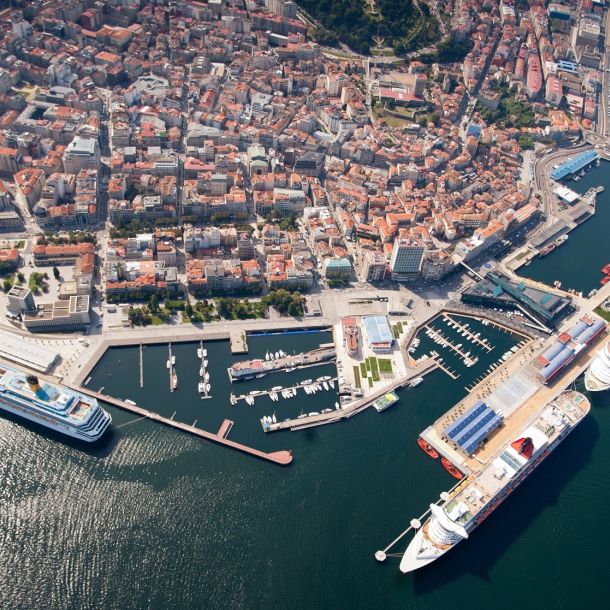The Lighthouse of the Cíes Islands, enjoy a viewpoint to paradise.
The lighthouse of the Cíes Islands, also known as the Faro do Monte do Faro, is the main lighthouse of the archipelago of the Cíes Islands and the Parque Nacional das Illas Atlánticas.
Located 178 meters above sea level and offering to all who visit it stunning views of the natural park, the Cíes Lighthouse is more than an important point of tourist interest and hiking trails destination, since today, in the middle of 2019, it continues to perform its maritime function and sending its flash from the coast as it has been doing for over 150 years.
- The Lighthouse of the Cíes Islands, enjoy a viewpoint to paradise.
-
Lighthouses of Galicia

Galicia, historic land of sailors, estuaries and open sea, has, more or less, a quarter of all the lighthouses along the Spanish coast. Our region is home to jewels of art and architecture such as the Tower of Hercules in A Coruña, the oldest lighthouse in the world.built in the second century, at the height of Roman culture and considered a World Heritage Site, or the Fisterra Lighthouse (in the picture), a window to the Atlantic that marks the end of the journey for most of the pilgrims who do the Camino. of Santiago.
Vigo and its islands have illuminated the ocean since time immemorial and for this reason it is firmly committed to active tourism through various routes that connect its lighthouses with those of the rest of the Rías Baixas. Here are emblematic points such as the Cabo Silleiro lighthouse, marking the border between Portugal and the province of Pontevedra, the Museo del Mar lighthouse, which offers the most spectacular views of the Vigo estuary, the Cabo Home lighthouse, at the entrance of the estuary at its northern end, in Cangas do Morrazo, and the Faro de Vigo lighthouse, in Cangas do Morrazo.In the heart of Vigo city, the Faro de la Guía, where the sick who were admitted to the Lazareto de San Simón used to disembark.
In the Cíes Islands, also belonging to the municipality of Vigo, there is not only the lighthouse of the Cíes Islands; five lighthouses are erected throughout the length and breadth of this treasure of nature. Would you like to discover them?
-
Lighthouses in the Cíes Islands
 The Cíes make up an archipelago consisting of three islands and some islets. From north to south are the Monteagudo Island, Middle Island or Lighthouse Island and San Martiño Island. Between the Lighthouse Island, named after the Lighthouse of the Cíes Islands, and Monteagudo Island, Rodas Beach stretches out, which naturally joins both islands.
The Cíes make up an archipelago consisting of three islands and some islets. From north to south are the Monteagudo Island, Middle Island or Lighthouse Island and San Martiño Island. Between the Lighthouse Island, named after the Lighthouse of the Cíes Islands, and Monteagudo Island, Rodas Beach stretches out, which naturally joins both islands.
In 1980, together with the islands of Ons, Sálvora and Cortegada, they became part of the National Park of the Atlantic Islands of Galicia. The Cíes Islands and their waters were thus protected from human impact on their ecosystems of high environmental value. It is one of only two recognized marine-terrestrial parks in Spain.
However, both the Vigo estuary and the Cíes Islands, which guard its entrance, have been home to settlements and human activity for centuries. That is why we can find up to five lighthouses among its cliffs and beaches.
On the island of Monte Agudo we find the lighthouse of O Peito. It marks the coordinates of the entrance to the Vigo estuary together with the previously mentioned Cabo Home lighthouse. It is powered by solar panels, favoring the ecological sustainability of the Cíes.
The Isla del Medio is home to the lighthouse of the Cíes Islands (Faro do Monte do Faro) and the lighthouse of A Porta. The Cíes Islands Lighthouse is the most notable and most historic of the islands and is located at a higher point than the A Porta Lighthouse (pictured), at 178 meters above sea level versus 83 meters. Even so, both have access on foot and are the destination of two of the four routes of the Cíes Islands.
In San Martiño we can visit the Faro dos Bicos lighthouse, at the southern tip of the island. The Cíes Islands also have the Boeiro Islet Lighthouse, although the latter cannot be visited.
-
History of Faro do Monte do Faro Lighthouse in Cíes
The lighthouse of the Cíes Islands crowns the so-called Monte del Faro de la Isla del Medio and is the most important of the archipelago. The lighthouse, built between 1851 and 1853, it was erected at the request of the English consul in Galicia.The ship’s owner, who communicated to the Ministry of State “the desire to put in his house, on dark nights, a guiding light on his landfall to the Cies Islands to take port safely”.
It presents a simple granite work, with walls 13 meters high, two balconies and a lantern. Initially, the lighthouse was illuminated by a large oil lamp. Later, it was changed to oil and, as early as 1939, an acetylene flashing lamp was adapted, which, with some improvements over the years, is still in operation today. Its signal is currently visible at 22 nautical miles, about 40 kilometers.
Next to it, also made of granite, stood a one-story house. This lighthouse was inhabited until the 1960s.. At that time, the family that operated the Cíes Islands Lighthouse were also teachers, so the few children who lived on the island went up to the lighthouse every day to school. This house no longer exists, the lighthouse system has been automated since the middle of the 20th century and the last renovation of the building dates back to 1980.
At the end of 2018, the Port Authority of Vigo, in charge of managing the Concello’s lighthouses, decided to devote just over one million euros to the restoration of the Cíes Islands Lighthouse and the Cabo Silleiro Lighthouse. The aim is to modernize the facades and the environment of the buildings, including the famous steep access between granite retaining walls, as well as to seek new solutions aimed at further improving Vigo’s tourism through hotel and cultural projects that involve the private sector, while maintaining its original function as a signpost.
-
How to get to the Cíes Islands Lighthouse
To visit the Cíes Islands, the best option is to walk any of the fourproposed hiking trails. If your destination is the Cíes Islands Lighthouse, the route you should take is known as the Monte Faro Route or Cíes Lighthouse Route, the longest and most popular for most of those who come to enjoy the park.
With seven kilometers of route, of medium difficulty and a non-circular type of route, the route starts at the information booth along the path that leads to the Faro Island, bordering the Rodas Beach and the famous Lago dos Nenos. This beach has been considered by some publications as the best beach in the world. If we turn our eyes towards the lake and the water has enough visibility that day, we will appreciate an explosion of life and nature.
Once we are on Faro Island, the route, guided at all times by signposts and beacons, passes by the Cíes campsite and the Nature Interpretation Center of the park. At 300 m, at the height of Playa de Nosa Señora, or Playa de Nuestra Señora, we will find the main crossing of this island.
Taking the path on the right we start a zigzagging ascent towards the Cíes Islands Lighthouse. The ascent has a considerable slopeIt is therefore advisable to be prepared, bring water and keep in mind that the upper part of the island has hardly any trees or shadows, so it is also advisable to use sunscreen.
Halfway we will come across Pedra de Campá, a curious bell-shaped rock formation, whose silhouette has been, over the millennia, slowly perforated by the Atlantic winds loaded with saltpetre from the ocean. Continuing the walk, we will be able to enjoy the bird observatory and contemplate the colonies of yellow-legged gulls and shaggy cormorants that live among the cliffs.

Once we return to the main path, we will continue the ascent to the top of the mountain to reach the Lighthouse of the Cíes Islands and its emblematic viewpoint, where we will get the best view of the three islands, the beaches and the entire Ría de Vigo. These special views compensate for the effort made during the climb.
On our trip to the Cíes Lighthouse we can also connect with other routes that guide us to the rest of the lighthouses of the archipelago. Along the route, for example, we can take a detour to take the A Porta Lighthouse Route, which is less traveled and of lower difficulty than the previous one.. Also from the information booth, but turning towards Figueiras Beach, The Monte Agudo Route, which will lead us to the Fato de O Peito, and the Alto del Príncipe Route, from which you can admire the whimsical geological formations of the west coast of the archipelago.
-
Visit the Cíes Lighthouse with Naviera Nabia
Trips to the Cíes Islands can only be made by sea, either by private boat or through a shipping company. In order to visit this magnificent corner of the Galician coast, Naviera Nabia offers you the services of the most modern fleet to make the trip between the Cíes and the ports of Vigo and Cangas.
The boat trip to the Cíes Islands takes about 45 minutes. We have a regular line during the high summer season and at Easter. You can find us directly at the ticket offices located in the port of Cangas and in the port of Vigo.
We also offer ticket sales at www.piratasdenabia.comOur website where you can find information about schedules and rates, the latest news, a careful selection of photos and images of the nature of the islands and our boats, different phone numbers and contact information, many articles about the surprises hidden in the National Park and, of course, all the information about the Cíes Lighthouse.
You can also follow us on our social networks. That’s right, the Pirates of Nabia have landed on Facebook, Twitter, Instagram and Youtube. If you want to keep up to date with all the news, learn about our activities and discover the little treasures of our estuary, don’t hesitate to look for us on the web!
-
The Cíes Islands Lighthouse, a viewpoint of paradise

In front of the lighthouse of the Cíes Islands, located at the highest point of the heart of the Vigo estuary, time seems to stop and the immensity of the Atlantic Ocean waters merges with all those who contemplate them, leaving the traveler with an indelible memory. For almost two centuries, it has been an impassive witness to the development of the islands, the comings and goings of its birds, the richness of its habitats and the renewed interest in its extraordinary natural heritage. Do not wait any longer and get to know the Cíes Islands Lighthouse, a watchtower in the middle of a paradise.


